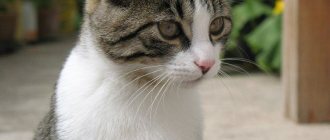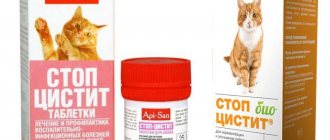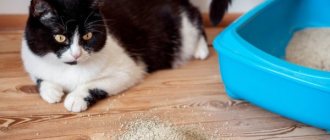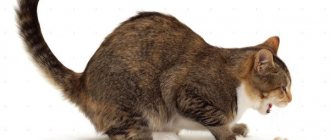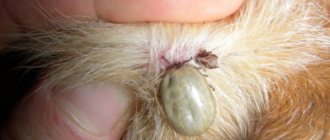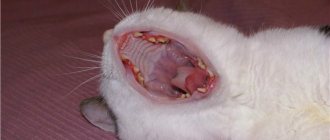Save the article:
One of the serious and common diseases in cats is cystitis. Regardless of the form in which it occurs, its manifestations cause great problems for the animal. To prevent cystitis in cats, you need to know the causes of its occurrence and preventive measures. And if the disease is diagnosed, adhere to the prescribed treatment.
global $ads_google; //data-ad-slot=”2475549904″ $ads_google = empty($ads_google) ? false : true; ?> if ($ads_google == false) {?> $ads_google = true; ?> } ?>
Features of the disease in cats
Cystitis is an inflammatory process that develops in the walls of the bladder. The violation can be provoked by several reasons, from banal hypothermia to serious infectious infection. At the initial stage of development, the disease practically does not make itself felt, which is why precious time allotted for treatment is lost. Only an increase in drinking rate and more frequent trips to the toilet can suggest the development of cystitis.
The early stages of the disease usually go undetected
The inflammatory process with such a disorder develops directly inside the bladder on its mucous membrane. The main symptoms of the disease appear when the walls of the organ become tense, when urine begins to put pressure on them. After emptying the bladder, the cat experiences relief for a while. But given the deepening of inflammation in the walls of the organ and the spread of bacteria, the pain becomes constant.
Cystitis affects both the genitourinary system as a whole and the kidneys
If left untreated, cystitis causes serious complications throughout the entire urinary system, gradually rising up and reaching the kidneys. Bacteria can also enter the bloodstream and cause damage to the reproductive system.
Treatment of cystitis in cats is practically no different from treatment of the disorder in humans. The difference is due to the selection of more gentle doses and different durations of the course of suppressing inflammation.
Video - Cystine leakage in a cat
Types of pathology
Piroplasmosis in cats: symptoms and treatment
In veterinary medicine, there are two types of cystitis:
- acute form. It manifests itself as a sharp deterioration in the functioning of the genitourinary system. The animal owner’s task is to immediately take the animal to the veterinarian for examination if signs of concern are detected;
- chronic form. Its difficulty lies in the fact that the pet rarely shows anxiety and only during urination. The owner may not notice the symptoms. This will cause the condition to worsen every day, weakening the immune system.
For your information! There are often situations when, without lack of treatment, the chronic stage turns into acute.
Main factors and causes of cystitis development
The following reasons can lead to the formation of a violation:
- improper nutrition of the cat, due to which metabolic processes in the body begin to be disrupted, stones are formed that injure the walls of the bladder and lead to symptoms of cystitis;
- infectious lesions of the urinary system and adjacent organs;
- insufficient fluid in the diet and water with a high content of minerals, which can lead to the formation of stones and salts;
The ability of cats to go without moisture for a long time does not mean that an empty bowl of water can be ignored
- insufficient nutrition or overfeeding of the cat;
- development of urolithiasis and bladder injury;
- stress experienced by the animal;
- hypothermia.
Tense posture when urinating in a cat with cystitis
You cannot think that hypothermia of a cat’s body occurs only in outdoor conditions during the cold or rainy season. Sleeping in a draft, on thin bedding, a bare floor, or swimming in water can ultimately lead to negative consequences and the occurrence of cystitis.
What to feed when sick
Poor nutrition can lead to metabolic disorders or urolithiasis, which contributes to the occurrence of cystitis. After the diagnosis is made, it is necessary to adhere to the rules of nutrition until complete recovery, and best of all, constantly, to avoid relapses.
When feeding an animal with cat food, you need to replace regular food with medicinal food.
Basic rules for feeding cats with cystitis:
- do not give food from the human table;
- do not overfeed;
- when eating natural products, focus on protein foods - dairy products and lean meat;
- When feeding an animal with cat food, replace regular food with medicinal food, for example, for animals with diseases of the lower urinary tract.
Main signs and symptoms of cystitis in cats
You can suspect the presence of a disorder in your pet’s body by the presence of signs typical of bladder inflammation:
- The cat constantly runs to the litter tray to urinate. Often the animal does not manage to get to the toilet, and gradually the pet begins to shit all over the apartment;
- Taking into account the complication of the condition, the animal will feel a constant urge to go to the toilet, but it will not be able to excrete even a small portion of urine;
A cat's unsuccessful trips to the toilet should be a wake-up call for the owner.
- Frequent urges are additionally accompanied by a loud scream, due to a feeling of pain and cutting in the urethra and bladder;
- The excreted urine is dark in color; there may be impurities of blood and stones if the animal additionally suffers from urolithiasis;
- With infections of the urinary system and the development of inflammation, pus may accumulate in the bladder, which gives the urine a rotten smell;
The characteristic unpleasant smell from pet urine indicates internal pathologies.
- Against the background of the inflammatory process, the animal’s body temperature rises, it can reach critical levels in the acute stage;
- The heat provokes fever, the pet refuses to drink and eat;
- The animal is lethargic, does not want to play and constantly lies down;
- When palpating the abdomen, the cat reacts sharply to the touch, as this area becomes painful and a feeling of fullness appears;
- Because of this symptom, the cat cannot lie on its stomach; lying on its side also causes discomfort.
In case of urinary incontinence, the cat is given special diapers.
If a cat experiences swelling in the extremities due to cystitis, we are already talking about the formation of nephrotic syndrome. It is associated with damage to the upper and lower parts of the urinary system.
The need to put a diaper on your cat may shock the owner, but there is nothing complicated or unusual in this procedure. Below are some basic tips for dressing your pet in diapers.
Diapers for cats: application and cost
Video: Symptoms of cystitis in a neutered cat
Conclusion
Cystocentesis can solve a number of problems at the stage of collecting a urine sample from an animal. The resulting sample will be sterile! This will allow for bacteriological examination of the sample. The sample will be reliable, which means that the information content of laboratory urine diagnostics will increase.
Obtaining a sample in compliance with the rules for fixing the animal, preparing the puncture field and soft, smooth insertion of the needle does not entail any negative consequences or painful sensations, but has a number of valuable advantages over obtaining a sample from the floor, tray, or by urethral catheterization.
Don't be afraid of cystocentesis! It's not scary or painful! But very informative.
Author of the article: veterinary therapist Svetlana Vyacheslavovna Pavlova
Diagnosis of disease in animals
To make a diagnosis, several medical procedures are required.
Table 1. Diagnosis of cystitis in cats
| Procedure | Leak details |
| In-person examination by a veterinarian | 1. The doctor collects anamnesis and assesses the external condition of the cat; 2. Palpation of the abdomen and bladder area is mandatory. |
| General blood analysis | 1. The doctor checks how much the leukocyte level has increased; 2. Registers the presence or absence of signs of infection; 3. Monitors ESR |
| General urine analysis | 1. The doctor evaluates the color of the urine and the presence of traces of blood in it; 2. Checks the level of leukocytes and casts; 3. Necessary for culture testing for sensitivity to antibiotics |
| Blood biochemistry | 1. It is carried out with the determination of the hepatic-renal complex; 2. Makes it possible to assess the severity of damage to the urinary system |
| Ultrasound | 1. Assess the degree of neglect of the inflammatory process; 2. Confirms or denies the presence of additional formations in the urinary system |
A cat undergoing an ultrasound
Preventive actions
Some preventive measures will reduce the likelihood of cystitis in a cat to a minimum. Among them, special attention should be paid to the following recommendations:
- the animal must eat fully and correctly, in accordance with its age and physiological characteristics;
- The cat must always have a bowl of clean water;
- The pet should not be allowed to eat only dry food; the diet should be varied;
- The mustachioed pet’s resting place should not be located in a draft, near an air conditioner or fan;
- do not feed the cat “from the table”, completely eliminate smoked, fatty, fried and spicy foods, as well as sweet foods;
- exclude stressful situations - do not punish physically and do not put pressure on the psyche;
- If your cat has already had cases of bladder inflammation or other diseases of the urinary system, it is important to carefully monitor its condition, preventing the development of exacerbations and always having medications on hand.
Recovery can only be achieved if the specialist’s instructions are followed. It should be remembered that cystitis in cats can return at any time, so the owner is required to love and take care of his pet, providing him with timely assistance.
First aid for cystitis in cats
If your pet shows signs of illness, follow these recommendations:
- immediately seek medical help for detailed consultation;
- do not give your pet any painkillers, with the exception of antispasmodics, but you should tell your doctor about their use;
- before contacting a specialist, you need to completely remove food, which will reduce the load on the kidneys and reduce the concentration of urine;
By limiting your pet's food, you will help him by relieving additional stress on his kidneys.
- at the same time, it is strictly forbidden to change the drinking regime; it is even recommended to increase it, which will allow bacteria to be removed from the body faster;
- the cat should be warm and at rest at all times;
- If there are children and other animals at home, the sick pet must be isolated.
Cystitis is dangerous due to rapid dehydration of the body, therefore a sick cat should be provided with good water
You cannot feel the animal’s belly on your own. Cystitis may be accompanied by blockage of the urinary canal, which causes stretching of the bladder walls. Excessive external pressure only increases the tension of the organ and can lead to its rupture.
Care during illness
The recovery of the mammal depends not only on the specialist. A person must surround the four-legged animal with care and attention, and strictly adhere to all the doctor’s recommendations. Treatment is comprehensive, combating the problem comprehensively:
- taking all necessary medications;
- provision of dietary rations;
- maintaining a rest regime;
- regular transportation to appointments and examinations;
- creating a favorable microclimate in the house (optimal temperature, humidity, absence of drafts);
- limit any stressful situations (exhibitions, breeding, etc.);
- access to fresh, clean water at any time of the day.
If you approach all points thoroughly, your cat’s health will soon improve. It is very important after full recovery to prevent relapses and take the necessary measures to prevent cystitis.
Effective drugs against cystitis
During treatment, complex medications should be selected to eliminate cystitis. An antibiotic must be prescribed, which has the main antibacterial effect.
Table 2. Medicines against cystitis
| Name | Dosage | A course of treatment | Description |
Stop Cystitis | Tablets: 1 tablet for cats weighing up to five kilograms and 1.5 tablets for cats weighing over five kilograms Suspension: 20 ml for cats up to five kilograms, if the specified weight is exceeded - 30 ml | The number of daily doses and course duration are discussed separately for each individual. | A drug developed specifically for the treatment of cystitis in cats. It is distinguished by its natural composition, which includes nettle, birch, lingonberry and horsetail. Has a complex effect, eliminating inflammation, pain, protecting the pet from the formation of stones |
No-shpa | In the form of injections in a dosage of 0.5 ml morning and evening | No more than one week | An antispasmodic drug that eliminates pain and discomfort when urinating |
Cyston | 0.25-0.5 tablets morning and evening | Up to one month or more, if the condition of the individual requires it | A natural drug that suppresses the signs of cystitis. Well tolerated in combination with antibiotics. The dose depends on the severity of the disorder, the age of the cat, and its condition. literal courses are carried out when inflammation is combined with urolithiasis |
Ceftriaxone | For cats weighing up to two kilograms - 0.5 ml, if this weight is exceeded, the amount of active substance doubles | Up to 10 days (for severe infection) | A powerful antibacterial drug to suppress the growth of bacteria. When treating cystitis in cats, it is used in the form of injections, which are given in the area of the hind paw or thigh. |
Papaverine | 0.5 ml morning and evening | No more than one week | A medication that relaxes smooth muscles, relieving spasms and pain. Also prescribed in the form of injections |
Enrofloxacin | 5 mg/kg daily | no more than 10 days. For moderate and mild infection, the duration of treatment can be 5-7 days | Broad-spectrum antibiotic. Used to relieve pain, inflammation and swelling. Injected subcutaneously |
| Erythromycin | 10-20 mg/kg. The number of daily doses depends on the severity of the disorder. On average - 2 or 3 times a day | Up to two weeks | Broad-spectrum antibiotic. For use in cats only subcutaneously. The lower the weight and age of the cat, the less active substance is administered to it. The number of daily doses depends on the severity of the disorder |
Kotervin | 2-4 ml morning and evening | 7 days. In the future, every 12-16 weeks the product can be used as a prophylaxis | The drug is a sterile solution for oral use. It is distinguished by its most natural composition, which includes knotweed, steelhead root, and horsetail. Once opened, the bottle should not be stored for more than one week. |
All the medications described have analogues. But you cannot replace one drug with another without specifying the new dose and course of treatment. Products with similar effects may have different auxiliary components, which will ultimately lead to allergies.
Unauthorized replacement of some medications with others can lead to a deterioration in the pet’s condition.
Traditional methods of treating disease in cats
Herbal infusions are especially helpful in the presence of bladder inflammation. But they should still be combined with traditional drugs, since cystitis requires a serious antibacterial effect on the site of inflammation.
Table 3. Herbal remedies against cystitis
| Compound | A course of treatment | Recipe | Dosage |
| Plantain, bloodroot and horsetail | 3-7 days | 1. Take plantain, bloodroot and horsetail; 2. In a ratio of 2:1:1, combine and chop the products accordingly; 3. 2-5 grams of herbal ingredients pour 200-250 ml of boiling water; 4. Soak the ingredients for 20 minutes over low heat in a water bath; 5. Remove the broth and cool and bring with clean boiled water to the original volume | 10 ml 30 minutes before meals 4 times a day |
| Oak bark, linden flower part and bearberry | 3-10 days, taking into account the condition of the animal | 1. The ingredients are mixed in equal proportions and crushed; 2. Take a tablespoon of ingredients and pour 250 ml of boiling water; 3. It is necessary to soak the ingredients for 15-30 minutes over low heat, it is better to do this in a water bath; 4. After cooking, the mixture is removed and the plant grounds are completely removed. | Take 5-10 ml half an hour before meals 3 times a day |
| Birch leaves, juniper fruits and dandelion root | No more than 10 days. Minimum course of treatment – 3 days | 1. Combine ingredients in a ratio of 2:1:1; 2. If fresh ingredients are used, they must be washed thoroughly; 3. Having thoroughly crushed the components, pour 250 ml of boiling water into a tablespoon and leave for 8 hours; 4. After infusion, the grounds are removed, the solution should be filtered well | 3-10 ml taking into account the weight and condition of the animal in the morning and evening |
Some decoctions can have a positive effect, but do not forget about possible side effects
The use of natural ingredients does not exclude the occurrence of allergies in a cat. If your pet experiences unwanted reactions such as vomiting, rash, hives, itching, and diarrhea, you should consult a doctor and stop using home methods.
Treatment and prognosis
If you do not treat a cat for idiopathic cystitis, then in most cases the clinical signs disappear on their own after 3-7 days, but subsequently they manifest themselves in relapses.
However, if the animal continues to be affected by provoking factors, the disease drags on and becomes severe, requiring the insertion of a catheter.
Therefore, when symptoms of this pathology appear, it is necessary:
- take measures to increase water consumption;
- transfer the animal to a well-chosen diet;
- apply symptomatic therapy;
- provide the cat with a favorable psycho-emotional atmosphere;
- eliminate the root cause of cystitis.
You can ensure the maintenance of water balance in the animal’s body by observing the following rules:
- the presence of several containers with fresh water in the house;
- installation of special fountains with running water;
- use of wide ceramic dishes with low sides.
The owner should place water bowls and fountains in places where the animal feels most comfortable.
Diet therapy
A proper diet is a must for eliminating symptoms and treating idiopathic cystitis in cats.
Diet therapy should be aimed at:
- decreased urine concentration;
- elimination of intoxication;
- maintaining the optimal weight of the animal (if necessary, reducing body weight);
- preventing the formation of kidney stones;
- Providing the cat’s body with the necessary vitamins, minerals and polyunsaturated fatty acids.
If the cat's diet was previously based on dry food, then it should be replaced with canned food and pates. It is best to choose ready-made super premium or holistic food.
On the recommendation of a veterinarian, you can introduce into the diet food intended for cats with lower urinary tract problems. They are balanced in such a way as to prevent the formation of kidney stones and saturate the animal's body with Omega-3 polyunsaturated fatty acids.
Important! You should not feed cats vitamin and mineral complexes without a veterinarian's prescription.
If your pet is overweight, you should reduce the calorie intake and portion size.
When feeding a natural diet, it is necessary to exclude from the cat’s diet:
- whole milk;
- meat by-products;
- fish products;
- legumes;
- vegetables that can cause bloating and increase intoxication (potatoes, white cabbage);
- nuts;
- sweets;
- salt;
- smoked, pickled, fried, spicy foods;
- sausages and canned food intended for human consumption.
Allowed products for idiopathic cystitis:
- lean meats after heat treatment;
- a small amount of homemade cottage cheese and yogurt;
- sea fish;
- boiled chicken egg whites or quail eggs;
- baked apples, pears;
- stewed and grated carrots, broccoli, zucchini.
Fish should not be given more than 2 times a week.
If such a possibility exists, then to competently draw up a menu, you should contact a veterinary nutritionist.
Drug therapy
Treatment of idiopathic cystitis is carried out only by a veterinarian, based on medical history, symptoms and results of laboratory tests.
The table shows groups of drugs that help eliminate clinical signs of the disease and reduce the likelihood of complications developing in a cat.
| Clinical manifestations of the disease | Drug groups | Name of drugs |
| Pain syndrome | Analgesics | Buprenorphine |
| Urethral spasm | Antispasmodics | Acepromazine, Prazosin, Phenoxybenzamine, |
| Bladder lining deformation | Glycosaminoglycans | Hyaluronic acid, Keratan sulfate |
| State of stress | Antidepressants | Amitriptyline |
| Inappropriate behavioral reactions | Pheromones | Feliway |
Important! It is strictly forbidden to use antidepressants on your own to treat cats.
Also, for idiopathic cystitis, you should not use glucocorticoid drugs, as they have proven to be ineffective in treating this disease.
Features of caring for a cat with cystitis
When eliminating the disease, you must adhere to a number of mandatory tips that will avoid further spread of the disease and deterioration of the cat’s condition:
- Provide your pet with warmth and comfort. He should not sleep on tiles or other cold surfaces;
- Do not use a heating pad or other warming devices. They can increase bleeding and the rate at which bacteria spread;
Any warming of the affected area is fraught with infection.
- Do not combine traditional drugs with folk ones on your own, as such combinations can provoke acute side effects, including anaphylactic shock;
- The diet should be as balanced as possible; it is better to switch exclusively to professional food during the period of therapy;
- If the cat goes outside, it is better to avoid any walks during treatment. The exception is warm days, during which it is allowed to carry your pet in your arms;
During the illness, limit your pet’s contact with the street as much as possible.
- You should not bathe the animal until all symptoms of the pathology have completely disappeared.
It is especially important to monitor the comfort of the pet for those owners who have weakened, lactating and pregnant individuals. In them, the infection spreads several times faster and can reach the kidneys in the first days.
Some individuals suffering from incontinence are recommended to wear special diapers that absorb discharge. Read below to learn about what cat diapers exist and how to make them yourself.
Diaper for a cat
How to prevent the appearance of cystitis
Preventive measures to prevent the development of pathology are as follows:
- It is recommended to ensure that the animal has its own place at home where it will feel safe;
- the bowl of food should be placed in a quiet place so that the pet can calmly eat;
- It is important to keep the tray clean and change the filler regularly;
- keep the animal active. Play with him more often. Veterinarians recommend using interactive bowls. The cat will have to work hard to get food.
It is important to maintain both the physical and psychological condition of your pet in a normal manner.
Thus, cystitis in a kitten is a serious disease that is difficult to diagnose. Pet owners need to closely monitor the health of their pets and changes in their behavior. If the pathology is left untreated, it can lead to the development of serious complications.
Cat food for bladder inflammation
During the therapy period, it is necessary to minimize the load on the kidneys and the entire body of the animal. When using professional feeds, preference should be given to premium and super-premium products. It is as balanced as possible and designed taking into account the characteristics of the animal.
Advance
It produces a whole line of medications taking into account the age of the pet; there is dry and wet food for weakened and pregnant cats. The composition contains a large number of minerals and vitamins. The feed itself partly consists of meat components and by-products. Cat owners speak positively about the food, noting its quality and affordability. Produced in Spain.
Feed Advance
Bozita
It also produces dry and wet food, produced in Sweden. The product line allows you to choose food for neutered, aged, young and especially large cats. The feed contains no by-products; only pure chicken, beef, rabbit and fish are used. It is not used in the prevention of urolithiasis, as it does not have enough minerals and vitamins; sometimes traces of corn flour can be found.
Bozita food
Eukanuba
It has a separate line of food for cats suffering from kidney and urinary system diseases. Additionally, it is possible to choose dry or wet food, taking into account the age of the pet; it is produced in Holland and Russia. Products of this brand are recommended for sick animals; the components are balanced and easily digestible. They do not cause allergies, so they can be prescribed even to sensitive and allergenic pets.
Eukanuba food line
Royal Canin
The widest range of products for cats of different ages and suffering from various diseases. Properly selected food not only speeds up the elimination of the inflammatory process, but also protects the animal from the appearance of stones and kidney problems in the future. Some owners note the insufficient amount of meat components in canned food and their rather high cost.
Royal Canin for sterilized cats
Happy Cat DE
The German brand has the most enriched composition. It contains no vegetable protein, only meat components and offal. Available in the form of dry food and canned food. There are products for sick cats, kittens, weakened and pregnant individuals. You can also choose food based on your pet’s weight for neutered individuals. The composition contains algae, fruits and medicinal herbs.
Happy Cat DE line of food for domestic cats
Happy Cat IT
Italian brand developed in partnership with veterinarians. It produces dry and wet food taking into account the age of the cat and its health condition. There is a line for sick animals suffering from disorders of the kidneys, liver, and heart. There are foods for obese cats. The composition is enriched with a large number of meat ingredients and vitamins.
Happy Cat IT pate with turkey
Additionally, a cat's diet for cystitis should be enriched with boiled meat; chicken and rabbit are suitable. Boiled bird hearts and gizzards also have a beneficial effect on the body and do not cause intoxication of the body and concentration of urine. If dairy products are well tolerated, cottage cheese and kefir are useful, but they are given once a day in small quantities. Oatmeal and buckwheat porridge are healthy; they can be mixed with boiled meat.
The diet of a cat with cystitis should include various cereals

